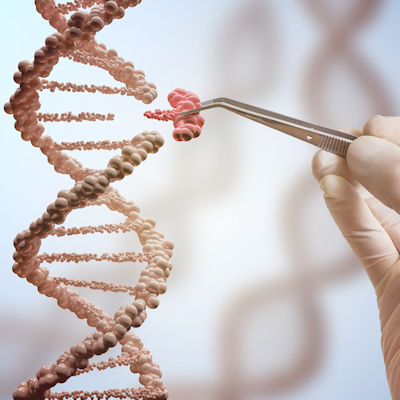October 20, 2020 -- A new CRISPR tool utilizes Cas3 to remove larger than normal stretches of DNA both quickly and accurately. This tool, described in an October 19 article in Nature Methods, could help fill a void in current gene editing capabilities.
Gene editing applications for the development of new treatments have focused on class 2 CRISPR systems that employ Cas9 or Cas12a enzymes. Alternatively, CRISPR-associated complex for antiviral defense (Cascade)-Cas3 systems offer new possibilities for large genomic deletions, such as targeted removal of entire genes or gene clusters.
In nature, type I systems are the most common form of CRISPR-Cas systems that are used to generate small deletions with homologous repair templates. Class I type I systems use Cas3 that has a 3'-5' single-strand DNA helicase-nuclease enzyme that degrades DNA "processively" (the concept of processivity refers to an enzyme's ability to catalyze consecutive reactions). Type I-C CRISPR-Cas systems use three cas genes (cas5, cas8, cas7) to produce a CRISPR RNA (crRNA)-guided cascade surveillance complex that can recruit Cas3.
In this new work, researchers from the University of California, San Francisco (UCSF) repurposed and optimized a Type I-C CRISPR system from Pseudomonas aeruginosa (PaeCas3c) for endogenous and heterologous genome engineering in four microbial species. The system resulted in deletions ranging from 7-424 kilobases surrounding a programmed target site with near 100% efficiency. Furthermore, cascade-Cas3 targeting outperformed Cas9 for generating large specific deletions. The authors noted that the cascade-Cas3 machinery can efficiently degrade entire genomes.
"Cas3 is like Cas9 with a motor -- after finding its specific DNA target, it runs on DNA and chews it up like a Pac-Man," said Joseph Bondy-Denomy PhD, principal investigator and associate professor in the UCSF Department of Microbiology and Immunology, in a statement.
The tool will enable researchers to more efficiently assess the importance of genomic regions that contain DNA sequences of indeterminate function, according to the authors. CRISPR-Cas3 will also enable biotechnology industry scientists to more easily remove potentially pathogenic or useless DNA from these cells during the development of small molecule or protein-based therapeutics. The technology should also allow entire genes to be inserted into the genome in industrial, agricultural, or even human gene therapy applications.
In order to use the tool in functional genomics, the CRISPR-Cas3 system must create large deletions within defined boundaries. Cas3 also has the potential to be recombinogenic through the generation of exposed single-stranded DNA. By manipulating the sequences of DNA provided to bacteria for homology-directed repair of the deletions in the study, the researchers were able to precisely set the boundaries of these large DNA repairs. This demonstrates that cascade-Cas3 is capable of genome-scale deletions that are currently not achievable using other CRISPR methodologies.
To enable expression of the system in other hosts, the researchers constructed a vector (pCas3cRh) that carried the I-C specific crRNA with a modified repeat sequence, cas3, cas5, cas8, and cas7. Induction of the targeting crRNAs resulted in 95%-100% of survivors being edited.
They subsequently tested the vector in Escherichia coli, which was used to target lacZ. Whole-genome sequencing revealed bidirectional deletions ranging from 17 to 109 kilobases encompassing the targeted region. In Pseudomonas syringae the team achieve three distinct applications: plasmid curing, single-step deletion of large virulence regions, and multiplexed targeting. They also showed the feasibility of Cas3 editing in Klebsiella pneumoniae.
Aside from the few model organisms that were tested in the study, relatively little is known about the more than one thousand bacterial species that normally reside in the human body.
"CRISPR-Cas3 is by far the most common CRISPR system in nature," said Bondy-Denomy. "About 10 times as many bacterial species use a Cas3 system as use a Cas9 system. Non-model microbes have largely been left behind in the genetics world, and there is a huge need for new tools to study them."
Do you have a unique perspective on your research related to synthetic biology? Contact the editor today to learn more.
Copyright © 2020 scienceboard.net








